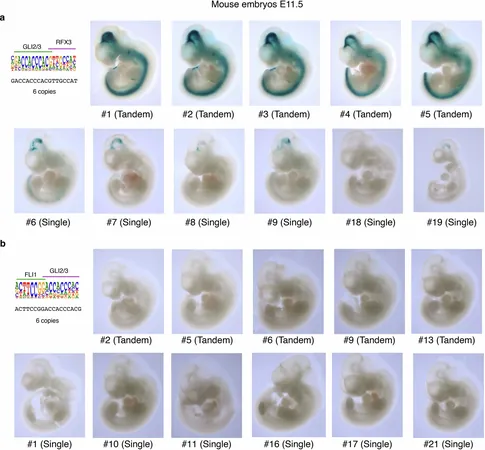
Unlocking the Secrets of Human Development: Groundbreaking Research on Gene Regulation
2025-04-09
Author: Siti
Revolutionary Insights into Gene Regulation
A groundbreaking study has shed new light on the intricate dance of gene regulation, revealing how specific protein sequences known as transcription factors attach to DNA to dictate the expression of human genes.
Collaborative Efforts from Leading Institutions
Published on April 9 in the prestigious journal Nature, this research is the result of a collaboration between the Wellcome Sanger Institute, the University of Cambridge, and other leading researchers. The team delved into the complex interactions between these protein factors, pushing the boundaries of our understanding of the genetic code.
Decoding the Language of Life
Each gene is equipped with a regulatory region containing the vital instructions on when and where it should be expressed, essentially acting as a language that transcription factors interpret. By binding to specific DNA sequences, these factors either amplify or suppress gene expression.
From Complexity to Clarity: The Hunt for Interaction Patterns
While previous studies have touched upon this regulatory 'language', they have unveiled the crucial role that collaboration among multiple transcription factors plays. The recent research takes this a step further by using innovative algorithms to analyze 58,000 pairs of transcription factors from human cells, allowing scientists to map out their interaction preferences more clearly.
Crucial Findings on Developmental Enhancers
Among their significant revelations, researchers uncovered distinct motifs—patterns that define how certain transcription factors interact. These motifs are found in developmental enhancers, key regulatory elements that initiate gene expression during critical growth stages, such as finger development. Fascinatingly, the study connects certain transcription factors' sequences to genetic conditions like polydactyly (extra fingers) and syndactyly (fused fingers).
Implications for Future Research and Technology
These findings open new avenues for future computational models, including the potential application of artificial intelligence to predict protein structures. While AI excels at modeling overall structures, it often overlooks granular details like transcription factor interactions that significantly impact human development.
A Step Toward Better Understanding of Genetic Disorders
This study not only advances our understanding of the nuanced 'words' in the genetic language but also serves as a key to interpreting the mechanisms of transcription factors, particularly in non-coding regions of the genome, which account for 99% of our genetic material. Although these areas don’t code for proteins, they play a pivotal role in regulating gene expression and disease risk.
The Future of Gene Research is Bright
Dr. Ilya Sokolov of the Wellcome Sanger Institute emphasized the research's potential to illuminate the molecular foundations of gene regulation, especially concerning developmental disorders. He insists that understanding these ancient interactions across mammals could revolutionize how we perceive development, allowing for sharper responses in gene expression.
With these advanced insights into the regulatory code, researchers are poised to significantly enhance our comprehension of human development and the roots of developmental disorders, paving the way for future breakthroughs.



 Brasil (PT)
Brasil (PT)
 Canada (EN)
Canada (EN)
 Chile (ES)
Chile (ES)
 Česko (CS)
Česko (CS)
 대한민국 (KO)
대한민국 (KO)
 España (ES)
España (ES)
 France (FR)
France (FR)
 Hong Kong (EN)
Hong Kong (EN)
 Italia (IT)
Italia (IT)
 日本 (JA)
日本 (JA)
 Magyarország (HU)
Magyarország (HU)
 Norge (NO)
Norge (NO)
 Polska (PL)
Polska (PL)
 Schweiz (DE)
Schweiz (DE)
 Singapore (EN)
Singapore (EN)
 Sverige (SV)
Sverige (SV)
 Suomi (FI)
Suomi (FI)
 Türkiye (TR)
Türkiye (TR)
 الإمارات العربية المتحدة (AR)
الإمارات العربية المتحدة (AR)